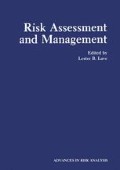Abstract
Comprehensive risk management must account both for the exposure and consequences of risks. Time budget analysis focuses on the activities and location of people, which are directly related to potential exposure, and consequences of risk. The analysis of the distribution of daily activities allows risk analysts to adjust exposure likelihoods for the changing population distribution over the course of a 24 hour period. In addition, time budget analysis allows the risk analyst to account for shifts in potential consequences associated with location of people at various times of the day. This paper examines three significant aspects of time budget analysis and risk management. First, the direct exposure rates to ongoing hazards as a function of the amount of time spent at risk (e.g. in an automobile, or airplane, or outdoors in a neighborhood adjacent to an uncontrolled hazardous materials site). Second, the effect on the likelihood of exposure to and severity of consequences for relatively sudden events (e.g. toxic chemical spills, radioactive leaks, other airborne risks transmitted via the plume-exposure pathway, tornadoes, earthquakes and flash floods). Finally, the effect on risk management through effective emergency management is directly related to location and activity of people at various times of the day (e.g. likelihood of warning receipt, probable evacuation flow dynamics, and likelihood of inadvertent adaptive location).
This research was partially supported by The Federal Emergency Management Agency (Cooperative Agreement No. EMW-K-1024). This report has not been reviewed by FEMA and in no way reflects the view and policies of the Agency. The authors accept full responsibility for the contents herein and gratefully acknowledge the support, comments and criticisms offered by colleagues at the University of Pittsburgh and the Annual Meeting of the Society for Risk Analysis.
Access this chapter
Tax calculation will be finalised at checkout
Purchases are for personal use only
Preview
Unable to display preview. Download preview PDF.
References
Albert, R., “Health Risks Associated with Arsenic Exposure,” Paper presented at the 1985 Annual Meeting of the Society for Risk Analysis, Alexandria, VA, October 7 to 9, 1985.
Baird, B. N. R.(et al.), “Public Judgement of Environmental Health Hazard: Two Studies of the ASARCO Smelter,” Paper presented at the 1985 Annual Meeting of the Society for Risk Analysis, Alexandria, VA, October 7 to 9, 1985.
Hicks, J. B. “Tight Building Syndrome: When Work Makes You Sick,” Occupational Health and Safety, January 1984, p. 51–56.
Johnson, G. “Air Pollution: The ‘Inside’ Story,” Industry Week, May 2, 1983, p. 45–50 ).
Juster, F. T., et al, “1975–1981 Time Use Longitudinal Panel Study”, The University of Michigan, Institute for Social Research, Survey Research Center, Ann Arbor, 1983.
Lowrance, W. W. Of Acceptable Risk: Science and the Determination of Safety, William Kaufmann, Inc. Los Altos, CA, 1976.
Nero, A. V. Jr., “Risk and Policy Implications of Indoor Exposure to 222Rn Decay Products and Other Indoor Pollutants,”Paper presented at the 1985 Annual Meeting of the Society for Risk Analysis, Alexandria, VA, October 7 to 9, 1985.
Michaels, D. “Workforce Valuable In Tracking Syndrome” Occupational Health and Safety January 1984, p. 34–57.
Mileti, D. et al., Human Systems in Extreme Environments, Institute of Behavioral Science, University of Colorado, Boulder, 1975.
Nehnevajsa, J., Personal Communication regarding research in preparation for hearings in connection with the Shearon-Harris Nuclear Power Facility, NC, October 1985.
Patrick, D. and W. Peters, “Exposure Assessment in Setting Air Pollutions Regulations: ASARCO, Tacoma, Acase Study,” Paper presented at the 1985 Annual Meeting of the Society for Risk Analysis, Alexandria, VA, October 7 to 9, 1985.
Polakoff, P. L. “Warming Up for Cold Weather Work” Occupational Health and Safety October 1982, p. 23–25.
Raloff, J. “Is Air Pollution Worse Indoors than Out?” Science News Vol. 128, p. 198, 1985.
Robinson, J. P., How Americans Use Time: A Social-Psychological Analysis of Everyday Behavior, Praeger Publishers New York, NY, 1977.
Rogers, G. O. and J. Nehnevajsa, Behavior and Attitudes Under Crisis Conditions, Government Printing Office, Washington D. C., 1984.
Rowe, W. D. An Anatomy of Risk John Wiley and Sons, New York, NY, 1977.
Shrader-Frechette, K. S. Risk Analysis and Scientific Method: Methodological and Ethical Problems with Evaluating Societal HazardsD. Reidel Publishing Co., Boston, MA, 1985.
Silva, M., L. Zaffanella, and N. Hummon, “An Activity Schedule Systems Model to Estimate Public Exposure to Hz Electric Fields,” IEEE Transactions on Power Apparatus and Systems, Volume PAS-104, Number 7, July, 1985.
Stafford, F., “Women’s Use of Time Converging With Men’s”, Monthly Labor Review, December, p. 57–59, (1980).
Stafford, F. and G. J. Duncan, “The Use of Time and Technology by Households in the United States,” Research in Labor Economics Vol 3, p. 335–375, (1980).
Stafford, F. and G. J. Duncan, “Market Hours, Real Hours and Labor Productivity” Economic Outlook USA, Autumn p. 74–76, (1978).
Author information
Authors and Affiliations
Editor information
Editors and Affiliations
Rights and permissions
Copyright information
© 1987 Springer Science+Business Media New York
About this chapter
Cite this chapter
Hummon, N.P., Mauro, L., Rogers, G.O. (1987). Time Budget Analysis and Risk Management: Estimating the Probabilities of the Event Schedules of American Adults. In: Lave, L.B. (eds) Risk Assessment and Management. Advances in Risk Analysis, vol 5. Springer, Boston, MA. https://doi.org/10.1007/978-1-4757-6443-7_36
Download citation
DOI: https://doi.org/10.1007/978-1-4757-6443-7_36
Publisher Name: Springer, Boston, MA
Print ISBN: 978-1-4757-6445-1
Online ISBN: 978-1-4757-6443-7
eBook Packages: Springer Book Archive

